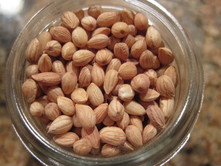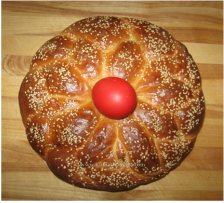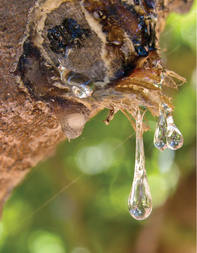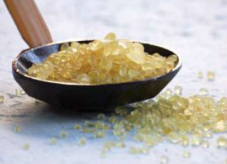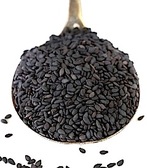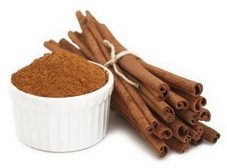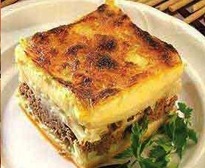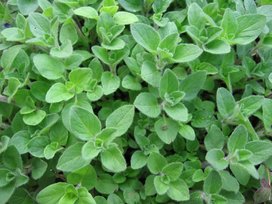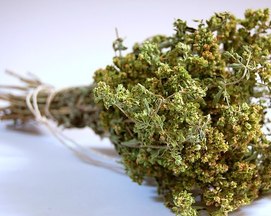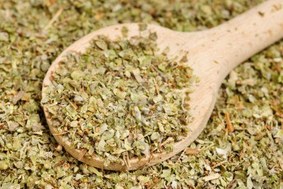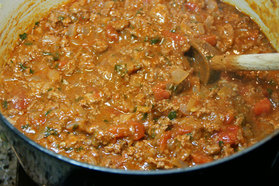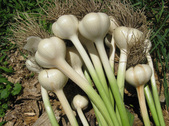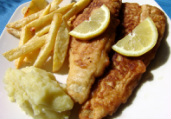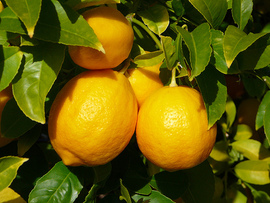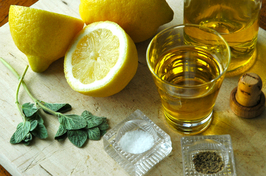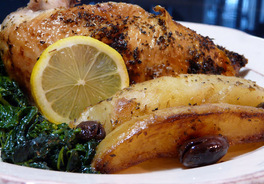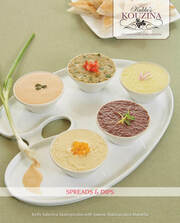Spice Up Your Cooking ~ Greek-Island Style!
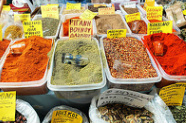
My Big Fat Greek Pantry
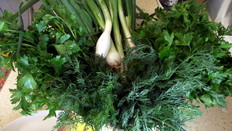
Once you have your grocery list ready, check out the stores and websites at the end that carry these items.
Greek Spices
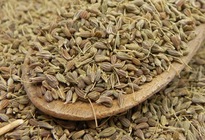
This seed is what gives ouzo its distinctive aroma, and flavors so many foods in Karpathian cooking. Because the seeds are potent, you only need a small amount to give breads, cakes, and pastries a tasty accent. We brew the seeds into a tea and add the strained liquid to recipes.
These seeds also have a medicinal, digestive use for easing gas pains in babies (and adults): Bring 1 teaspoon anise seed and 2/3 cup water to a boil, reduce heat and simmer 5 minutes. Strain and cool to warm. Babies love it because it has a natural sweetness, and it makes them feel better fast.
|
Mahlab seeds (mahlepi, μαχλέπι, pronounced mah-HLEH-pee)
Mahlepi seeds are the tiny (about 1/4 inch) dried pits of wild cherries native to the Eastern Mediterranean and Middle East. Mahlepi is sold as whole seeds and ground and should be light beige in color (they get dark when they’re old and stale). Whole seeds have a longer shelf life and can be frozen (in a heavy-duty freezer bag) up to two years. When ready to use, the seeds are ground using a mortar and pestle. This beautifully aromatic spice is used to flavor cakes, pastries, and holiday breads. Mahlepi gives tsoureki (Greek Easter bread) its trademark fragrance and fills the kitchen, and house, with its extraordinary sweetness when baking. |
|
Mastic (masticha, μαστίχα, pronounced mah-STEE-hah)
Masticha is the rare crystallized resin that seeps from the bark of the mastic tree (Pistacia lentiscus). The tree, indigenous to the island of Chios, also produces a wild pistachio. The resin, which drips in the shape of teardrops, has been the island’s trademark and largest export from ancient times, and is the main source of income for thousands of families on Chios. The value of the mastic trees on Chios has invoked numerous invasions by other civilizations as well as pirates. Masticate, meaning “to chew,” is derived from the word masticha, which is actually the word Greeks use for chewing gum, and it is believed that this was the very first gum in history. Masticha is used in a number of different products, including chewing gum, alcoholic beverages, breads, ice cream, syrups, and sweets. Before adding it to recipes, the crystalized resin beads must be ground into a powder, along with a little sugar from the recipe, using a mortar and pestle. The sugar keeps the mastic from sticking to the surface of the mortar and pestle (which it will do if you try to grind it alone) and allows it to be ground into a fine texture. |
|
Nigella seeds (black sesame, mavrosisamo, μαυροσíσαμο, pronounced mah-vrroh-SEE-sah-moh)
These small black seeds are about the size of sesame seeds and look like they could be black sesame but in fact are not sesame at all. They are picked from the Nigella sativa plant grown in Egypt and India. Nigella seeds are a spice as well as a seed, imparting a smoky, oregano-peppery flavor to recipes. The most common use is sprinkling them on breads, kouloures, and breadsticks, alone or combined with sesame. The essential oils in the seeds have antimicrobial agents and can benefit digestion by eliminating parasites. |
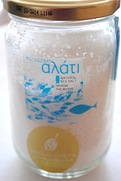
Amazing food requires high-quality ingredients—fresh vegetables, choice meats, and, yes, sea salt! Sea salt is the only salt used in traditional Greek cooking. Its natural, salt-water flavor is a far cry from the chemical taste of table salt and you will notice the difference. Sea salt also dissolves more easily than table salt when cooking, and it's flakey texture makes it lower in sodium per spoon measure, so it’s a healthier choice as well. Greek sea salt comes in fine, medium, and coarse crystals, is inexpensive, and can be found in Greek/Mediterranean stores, as well as online. For more on sea salt, check out our blogs: Sea Salt: Cook, Taste, Savor and Sea Salt: Meze to Dessert Recipes.
|
Cinnamon (kanela, κανέλα, pronounced kah-NEH-lah)
In stick form you can tell that cinnamon is the inner bark of a tree, a tropical evergreen tree to be exact. Both stick and ground versions are used in a wide array of dishes. From a subtle flavoring in meat sauces used in moussaka and pastitsio, to a more prominent taste in sweets like baklava and galaktomboureko, this spice is invaluable in the Greek kouzina. Ancient physicians prescribed cinnamon to improve circulatory health and today’s research suggests that it may reduce blood-sugar levels in diabetics (just ½ teaspoon per day). |
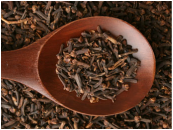
These dried, unopened flower buds of the tropical evergreen clove tree are a valuable spice worldwide. Clove’s aromatic, peppery flavor lends itself to a number of dishes from sauces and meats to desserts like karithopita (nut cake with syrup), cookies like kourambiethes and ahlathakia (almond pears), and spoon sweets.
For centuries, cloves have been chewed to eliminate bad breath and it’s not surprising that some Greeks always have a small bag they carry with them.
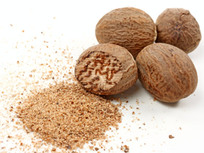
This dark-brown seed from the nutmeg tree is a lighter brown to tan color on the inside and has a warm, spicy-sweet taste. Though you can use it pre-ground, for the most aromatic and flavorful addition to your foods, we suggest you grate it fresh when you need it (you will notice the difference). You’ll find this spice in béchamel sauce (used in moussaka and pastitsio), potato croquettes, syrups, and cakes.
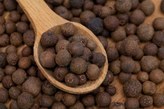
This pea-sized berry of the evergreen pimiento tree seems to embody the flavors of cinnamon, nutmeg, and cloves, hence the name. Sold in dried-berry and ground form, it’s best to grind the berries as needed for the freshest taste. A pinch goes a long way in tomato-based sauces, meats, and Karpathian breads.
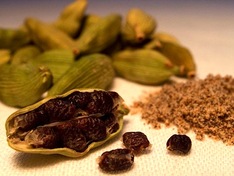
This aromatic spice is a member of the ginger family and takes the form of seeds in small pods. Cardamom is sold in seed (to grind for recipes) and finely-ground form. We use it ground in sweets and find this spice to be potent enough to last up to a year.
Ancient Greeks and Romans scented their perfumes with cardamom and ancient Egyptians chewed on the seeds to clean their teeth.
Greek Herbs
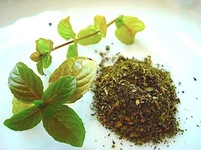
This herb is used fresh and dried, each imparting a very different taste and aroma to a wide array of dishes, including keftedakia/keftethakia (herbed mini meatballs), kolokithopita (zucchini pie), and dolmades/dolmathes.
This herb can also be brewed to make a cleansing herbal tea that aids in digestion and calms the stomach.
|
Greek Oregano (rigani, ρίγανη, pronounced REE-ghah-nee)
Greek oregano comes from the mountainsides of Greece and is known to control erosion. The name is taken from the ancient Greek "oros" (mountain) and "ganos" (joy), meaning "joy of the mountain." This herb is used fresh and dried (sold ground, and on stems in bunches, the latter being the more preferable, aromatic form). Greek oregano is the most fragrant of all the oregano varieties and is the “Opa!” in Greek salads, lamb dishes, and sauces, including roasted lamb and potatoes, Kapathian meat sauce, and sprinkled on feta slices with a drizzle of extra-virgin olive oil. Oregano tea has been used to treat indigestion, coughs, and inflammation. |
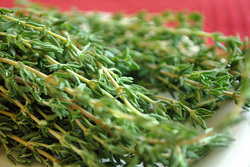
Both fresh and dried are used but the fresh is preferred. Thyme is widely used as an infusion for olive oil and vinegar, and in a number of dishes, including soups, stews, poultry, fish, and stuffed vegetables. It is also used to flavor breads and spoon sweets. Best of all, Greek-island honey is thyme scented, as this herb grows throughout the countrysides and bees love the nectar from its little purple flowers.
|
Marjoram (mantzourana, μαντζουράνα, pronounced mahn-dzoo-RAH-nah)
Used dried, this light, silvery green herb is similar to oregano but with a milder, slightly sweeter flavor. Originally from Greece, marjoram is usually added to recipes along with oregano and/or basil, resulting in the ultimate flavor combinations. This herb goes well with lamb, beef, pork, sausages, poultry, fish, soups, and tomato-based sauces—our Kukla’s meat sauce wouldn’t be the same without it! Centuries ago, marjoram was steamed in water and inhaled to clear sinuses and heal laryngitis…in fact, professional singers brew it as a tea and drink it with honey to keep their vocal cords in pitch-prefect shape. |
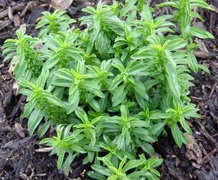
With a flavor between oregano and thyme, this herb is used fresh or dried to flavor olives, legumes, pork, grilled fish, soups, and stews.
Since ancient times, savory has been lauded for its medicinal use in a tea (brewed with mallow/moloha) to heal ulcers and control flatulence. Two kinds of savory are grown worldwide, a summer variety is used for cooking, and a winter variety is used medicinally.
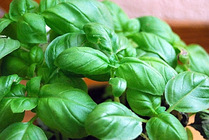
Fresh basil is always best but dried can also be used. Tomato-based recipes often include this herb, as well as vegetable, meat, poultry, seafood, and soup dishes. Basil’s sweetness pairs perfectly with oregano and marjoram.
Hippocrates considered basil to be a heart-healthy herb and also prescribed it for nausea and constipation.
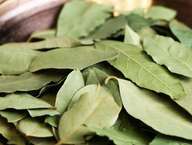
Whole dried leaves are used to flavor soups, stews, tomato sauces, meat, and seafood dishes. Once the dish is cooked, the whole leaves can be easily found, removed and discarded. This is one herb that adds flavor but cannot be eaten itself, as the leaf edges can be sharp and may cause internal injury. Never crumble a leaf before adding to a recipe unless you’re including it in a bouquet garni (tied in a cheesecloth bag).
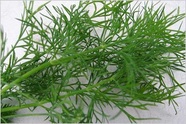
Greeks will only use fresh dill, as it looses most of its flavor when dried. This is the herb that gives the signature taste to tzatziki, magiritsa (Easter lamb soup), and a Greek omelet. Add dill during the last minutes of cooking to retain its essence.
Medicinally, dill has been brewed in a tea to cure insomnia.
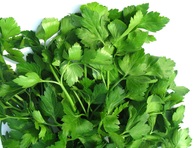
Like dill, only fresh will do! This antioxidant-loaded herb is rich in vitamins A, B’s, C, and is widely used in soups, sauces, and cheese fillings.
Ancient Greeks used parsley to aid digestion and to heal respiratory infections. Chewing on the leaves eliminates bad breath.
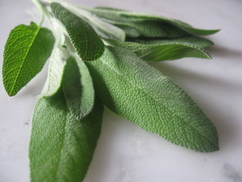
Both fresh and dried can be used. This strong, slightly bitter herb is mostly used to smoke meats and is added to wood-burning ovens when baking breads.
For medicinal purposes, it’s brewed as a tea to detoxify and speed healing when under the weather with a cold or virus. Hippocrates knew of its antiseptic and antibacterial properties and prescribed it for a number of ailments, including lung disease.
|
Garlic cloves (skordo, σκόρδο, pronounced skOHR-tho)
No matter how you slice, chop, crush, or mash it, ya gotta have garlic when it comes to making skordalia (garlic dip, σκορδαλιά, pronounced skohr-tha-LIAH), slow-roasted lamb, lentil soup, and a ton of other dishes. In Greek cooking, it usually partners with lemon juice or vinegar, which balances out the flavor of each dish perfectly. Eating garlic also helps to ward off a cold and lower cholesterol. Greek Flavorings |
|
Lemon (lemoni, λεμόνι, pronounced leh-MOH-nee)
Just about everything in Greek cooking has lemon in it and it adds iconic flavor to avgolemono soup, roasted chicken and potatoes, and custards. Bottom line, lemons are to Greek cuisine as curry is to Indian food. You’ll find lemon mostly combined with the other Greek essentials of olive oil, oregano, and garlic. Together, these four flavors can turn ordinary food into a Greek dish—poultry, fish, lamb, tomato salad, artichokes, sauces, and so much more—and the result will make you a hero in your own kitchen. Our favorite uses include ladolemono (olive-oil and lemon dressing, λαδολέμονο, pronounced lah-thoh-LEH-moh-noh) tossed with cooked broccoli or spinach, combined with oregano and garlic to marinate lamb and roast with potatoes, and combined with parsley to dress grilled or broiled fish. Growing up, our mom gave us cold lemon juice for nausea and warm juice for diarrhea. It worked every time and we’re never without lemons in our fridges! So when life hands you lemons, be Greek about it! |
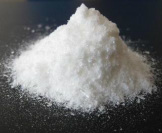
This is the only vanilla used in Greek baking because it’s the most flavorful component of the vanilla bean. It’s white in color, looks a bit like confectioners’ sugar, and is made up of tiny crystal flakes. The flavor is super concentrated compared to vanilla extract, so you would use a very small amount—a pinch usually does the trick. It imparts a pure vanilla essence to recipes without the aftertaste of alcohol (from the extract), making it perfect for custards, cakes, cookies, and breads. It’s a bit pricey but remember that a little goes a very long way, and it will make your Greek desserts taste like heaven, just the way they should!
Ready, Set, Shop!
Sahadi’s, 187 Atlantic Avenue, Brooklyn, NY
Titan Foods, 25-56 31st Street, Astoria, NY
Mediterranean Foods (2 locations in Astoria, NY): 22-78 35th Street | 30-12 34th Street
Titan Bakery, 15 West Jefryn Boulevard, Deer Park, NY
Not in New York? Here's where you can shop online for Greek spices and herbs if you can't find them in your area:
Sahadi's
Mediterranean Foods
Greek Internet Market
GreekShops.com
Parthenon Foods
We hope you enjoyed our journey down the Greek spice, herb, and flavor aisles. Stay tuned for more segments on uniquely Greek ingredients!
Sign up for our e-newsletter (if you haven’t already) and stay connected on social media for cooking tips and recipes, as well as for all Kukla's Kouzina updates and news.
Thanks for following us and we’ll see you next Monday!
Until then~
Kali orexi! Good appetite!
Kelly
Web design by Kelly Salonica Staikopoulos

